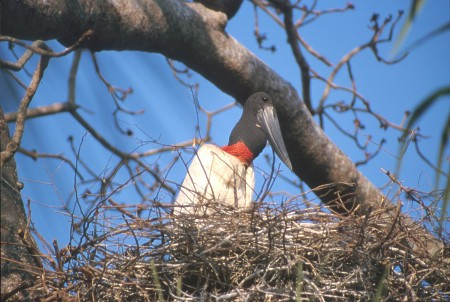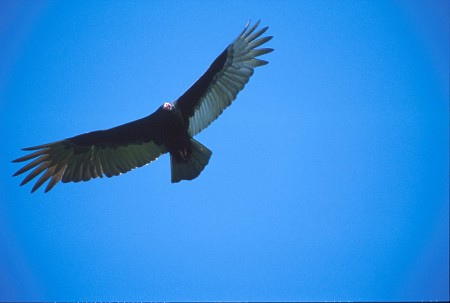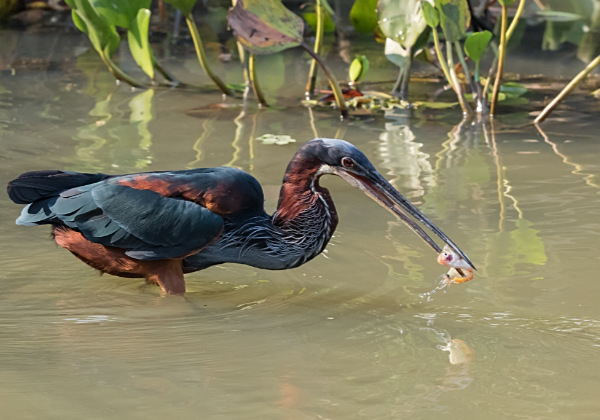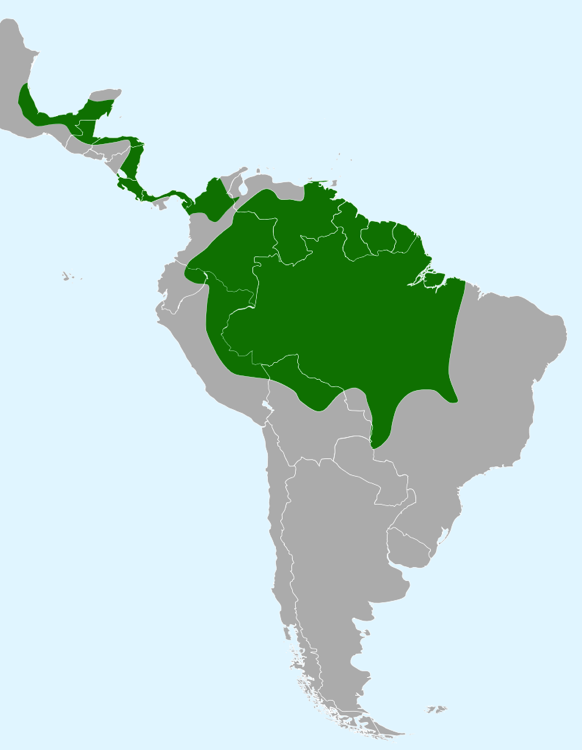Agami Heron
The Agami Heron (or Chestnut-bellied Heron) is possibly the most visually stunning water bird in the Pantanal - but is difficult to see (and photograph) due to its reclusive nature, and preference for shade and heavy vegetation.
Although present in the Northern Pantanal, they're not very common - but can sometimes be encountered around oxbow lakes and small streams. Any photographer wanting to capture images of an Agami Heron needs to exercise great patience. It will require a significant amount of luck to get a clear shot since agami herons rarely come out into the open - and usually only when panicked. And when they do come out, they'll quickly return back into the vegetation.
Agami herons stand about 60-76 cm tall and have a very distinctive multi-coloured plumage. This consists of a dark green back, with chestnut brown underside and neck. The neck has a long stripe running down the middle, at the front, and is bordered by sickle-like silvery-blue plumes. During the breeding season, both sexes develop ribbon-like silvery crest feathers up to 125 mm long - which have been likened to the birds wearing a wig of Einstein's hair.
 Audubon article on Agami Herons
Audubon article on Agami Herons
(Includes a photo of the heron's stunning breeding plumage)
Agami herons have a very long neck (when extended) relative to their body size compared to other heron species. They have a long needle-like bill, and yellow or olive-green legs. Both sexes are identical, except for the smaller size of the females.
Agami herons are a neotropical lowland species found in swamp-like wooded areas along the banks of streams, rivers, and lakes. They're typically only found in areas below 300m elevation, although there are a few exceptions where they've been seen at higher altitudes. The species' range extends downwards from eastern Mexico through Central America and the upper regions of South America - extending further down into the Brazilian and Bolivian Amazon. The northern Pantanal represents the southern-most point of its range.
There's a suggestion that the species' appearance in the Pantanal is recent, and that it might be related to habitat loss in the Amazon basin. If so, there may be risks for this species as the herons relocate into a new (and potentially less ideal) environment which sees them competing unsuccessfully with other better adapted species.
Agami herons stand about 60-76 cm tall and have a very distinctive multi-coloured plumage. This consists of a dark green back, with chestnut brown underside and neck. The neck has a long stripe running down the middle, at the front, and is bordered by sickle-like silvery-blue plumes. During the breeding season, both sexes develop ribbon-like silvery crest feathers up to 125 mm long - which have been likened to the birds wearing a wig of Einstein's hair.
(Includes a photo of the heron's stunning breeding plumage)
Agami herons have a very long neck (when extended) relative to their body size compared to other heron species. They have a long needle-like bill, and yellow or olive-green legs. Both sexes are identical, except for the smaller size of the females.
Behaviour and Habitat
Agami herons are a neotropical lowland species found in swamp-like wooded areas along the banks of streams, rivers, and lakes. They're typically only found in areas below 300m elevation, although there are a few exceptions where they've been seen at higher altitudes. The species' range extends downwards from eastern Mexico through Central America and the upper regions of South America - extending further down into the Brazilian and Bolivian Amazon. The northern Pantanal represents the southern-most point of its range.
There's a suggestion that the species' appearance in the Pantanal is recent, and that it might be related to habitat loss in the Amazon basin. If so, there may be risks for this species as the herons relocate into a new (and potentially less ideal) environment which sees them competing unsuccessfully with other better adapted species.
An Agami Heron spears fishing along a riverbank. Credit: Shutterstock/Kelp Grizzly Photography.
Related Links
Scientific Name
Agamia agami

Local Name
Garça-da-mata
(Wood Heron)

Description
Very striking heron, with distinctive multi-coloured plumage. It has a dark green back, a chestnut brown underside and neck. The neck has a long stripe running down the middle, at the front, bordered by sometimes sickle-like silvery-blue plumes. The Agami Heron stands about 60-76 cm tall, with a very neck (even in comparison with other hero species) when extended.
Within most of it's range, the agama heron is an uncommon and rarely encountered species. Agami herons are shy and prefer to stay hidden in mangroves or low foliage overhanging the water. Their habits are almost nocturnal, being mostly quiet during the day - and reputedly much more active at night or during early mornings and dusk. As with other herons, the agami herons' diet consists primarily of fish, frogs and molluscs - which they hunt by wading belly deep into shaded water and waiting motionless to spear passing fish. This diet is supplemented with other opportunistic prey which includes insects and small reptiles.
Reproduction
Until recently, relatively little was known about the Agami Herons' reproduction and courtship. The breeding season occurs in the period June-September, when the normally solitary animals group together into small colonies. Each colony numbers around six nests, and is sometimes mixed in with colonies of other heron species.
Courtship begins when the male chooses a nest site and starts displaying around it. It's then up to interested females to respond - signalling their interest by approaching the male and dancing. The female shakes her plumes, bows, rocks on her legs, and the normally yellow patches of skin on her face turn bright red. Males will often rebuff the female, sometimes aggressively, with their beaks - and the process may take several days. Once the male has accepted the female as his partner, they both proceed to build the nest.
Nests are typically built in a tree or bush 1-3 m above water - but remaining within cover of foliage. The nest is really just a thick platform of sticks and twigs rather than being the open cup structure more typically associated with bird's nests. The completed nest measures around 15 cm in diameter and 8 cm in height. When ready, the female generally lays a small clutch of around two eggs, which are coloured blue-green, and measure around 3.5 cm in diameter. No official incubation period is published for the species, but is likely in the range 28-32 days, as per other similarly sized heron species. After hatching, the young gain weight quickly - doubling their size within the first week. Again, given the very little information published about this species, it's uncertain how long it takes the chicks to fledge - but its probably in the range 6-8 weeks.
Conservation Threats
The species is categories as vulnerable by International Union for Conservation of Nature (IUCN), with the biggest threats coming from habitat loss associated with deforestation for cattle ranching and soy production. It is also susceptible to hunting.








Banner image:Agami Heron (Shutterstock/Tim Zurowski)
Footer images: Tuiuiú, Turkey Vulture(Andrew Mercer); Amazon Kingfisher (Shutterstock/Ecoventurestravel)


Pantanal Escapes